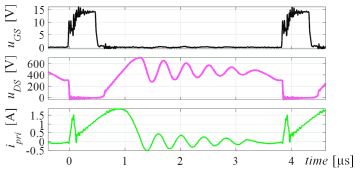ABSTRACT
The
demand of miniaturization of power systems has accelerated the research on
high-switching-frequency power converters. A flyback converter in resonant mode
that features low switching losses, less transformer losses, and low switching
noise at high switching frequency is investigated in this paper as alternative
to a conventional quasi-resonant flyback topology to increase power density. In
order to find a compromise between magnet size, electromagnetic interference
(EMI), and efficiency, the concept utilizes the resonant behavior between
transformer leakage inductance and snubber capacitor to achieve
near-zero-voltage switching at both turn-on and turn-off of the primary switch,
low core loss due to a continuous transformer magnetizing current, and reduced
EMI due to low di/dt and dv/dt values. Meanwhile, the concept uses the
regenerative snubber to recycle the transformer leakage energy with two snubber
diodes and one snubber capacitor. The proposed concept has been validated on a
340kHz 65W prototype. Compared to the conventional quasi-resonant flyback
converter operating at the same switching frequency, the proposed concept has
2% efficiency improvement and better EMI performance.
KEYWORDS:
1. Resonant
power conversion
2. High switching frequency
3. Flyback
4. Switching loss
5. Regenerative snubber.
SOFTWARE: MATLAB/SIMULINK
CIRCUIT
DIAGRAM:
Fig. 1 Proposed flyback converter,
(a) schematic of the proposed concept, (b) equivalent circuit of the proposed
concept.
EXPECTED SIMULATION RESULTS:
Fig. 2. Measured waveforms of
resonant-mode operation, D = 0.6. (a) Switch Si voltage and
current; (b) Current of each transformer winding (c) Snubber diode current,
resonant capacitor voltage and current.
Fig.3. Measured waveforms of
resonant flyback at high input voltage, Ui=360V, fs=250kHz, Po=38W.
CONCLUSION
In this paper, a
flyback converter in resonant mode is proposed to enable soft switching, less
transformer loss and reduced EMI at high switching frequency. Experimental
results show that, compared to the conventional flyback converter operating in
QR/DCM and while achieving the same specifications, both the fundamental
quasi-peak and the high-frequency harmonics in the measured common-mode EMI are
reduced due to the resonant behavior, and the switching loss on the primary
switch is minimized due to the achieved soft switching in both turn-on and
turn-off of the primary switch. Furthermore, the transformer core volume is
reduced by one third compared to the low-frequency conventional flyback
converter. In conclusion, the resonant-mode operation of the developed flyback
converter enables higher power density, high efficiency and better EMI
performance at high switching frequency. Therefore, the improved flyback
topology is suitable for low-power isolated DC/DC converters with limited input
voltage range.
REFERENCES
[1] R.
Watson; F.C. Lee; G.C. Hua, "Utilization of an active-clamp circuit to
achieve soft switching in flyback converters," IEEE Transactions on
Power Electronics, pp. 162 - 169, Jan 1996.
[2] Y.
Xi; P.K. Jain; G. Joos; Y. Liu, "An improved zero voltage switching
flyback converter topology," in 29th Annual IEEE Power Electronics
Specialists Conference, Fukuoka, May 1998.
[3] Ching-Lung
Chu; Ming-Juh Jong, "A zero-voltage-switching PWM flyback converter with
an auxiliary resonant circuit," in International Conference on Power
Electronics and Drive Systems, Taipei, Nov. 2009.
[4] Y.
Wei, X. Huang, J. Zhang and Z. Qian, "A Novel soft switching flyback
converter with synchronous rectification," in IEEE 6th International
Power Electronics and Motion Control Conference, Wuhan, May 2009.
[5] "NCP4304:
Secondary Side Controller," ON Semiconductor, 2015. [Online]. Available:
http://www.onsemi.com/.


